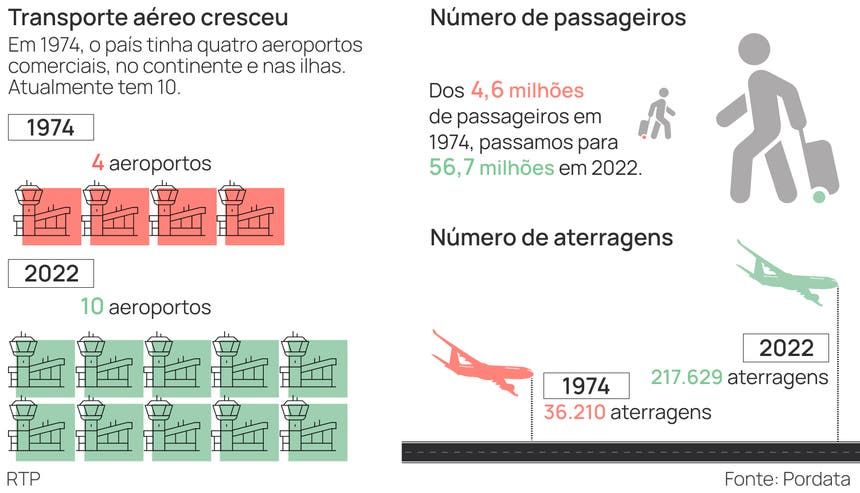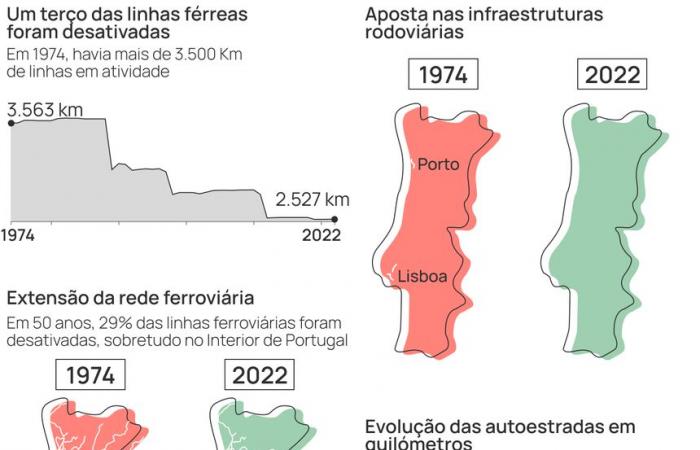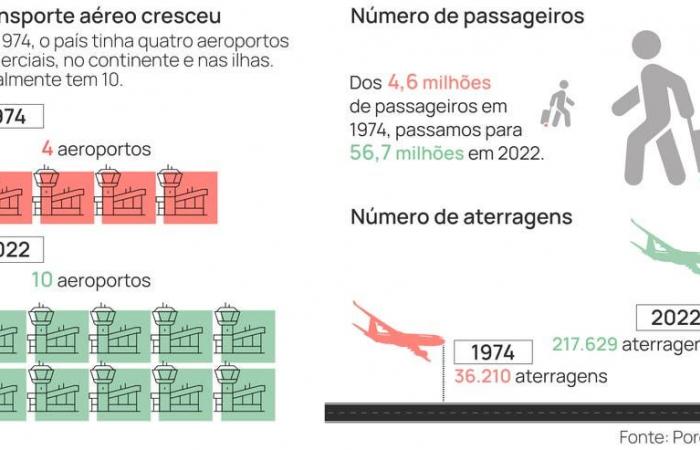The Portuguese population of working age (15 to 64 years old) is now around 6.6 million, of which 84.9 percent are employed, around 20 percent more than 50 years ago (67.5 percent in 1981).
The average unemployment rate has varied between four and six percent since the 1980s, not counting the worsening felt at the beginning of the century.
The minimum wage was around 16 nominal euros in 1974 (3,300 escudos), calculated as an annual value (14 months) divided by 12 months and corresponding to a real value of 629 euros. In 2023 it was 956.7 euros.
The country today has more than one million and 400 thousand companies, compared to barely 580 thousand in the 90s. Currently, Portugal catches a third of the fish it did 50 years ago and produces almost twice as much olive oil.
Portugal now has practically 650 thousand retirees, pensioners and retirees, in 1974 there were just over 73,500.
Social benefits corresponded to five percent of GDP in 1977, in 2022 they were already 12 percent. The largest share goes to pensions for the elderly, now 8.3 percent of GDP, compared to 3.1 percent in the 1970s.
Other social benefits are residual, around less than one percent, with unemployment benefits three percentage points higher than five decades ago. Support for families is, on the contrary, lower in the same three points. Should and have
In economic terms, the Portuguese trade balance is currently more balanced. On the other hand, the Portuguese are only able to save in gross terms around six percent of what they earn (provisional data), whereas in the 1970s gross savings were almost 24 percent.
This is despite private consumption as a percentage of Gross Domestic Product remaining almost unchanged, at around 64 percent. Public consumption is now six tenths higher (11.5 to 17.6 percent of GDP) than it was 50 years ago.
Five decades ago, GDP was 83,019,893 ME, in 2022 it was 211,154,257 ME.
The inflation rate today is 7.8 percent, almost double that experienced during the Carnation Revolution, 4.3 percent.
In 1974, and despite a positive 1973, the trade balance was negative for Portugal, with imports exceeding exports by 11.6 percent.
Fifty years later, in 2023, Portugal had grown as an importer, but the weight of exports had more than doubledwith a difference of 1.2 percent in favor of national accounts.
It should be noted that, from the 1980s onwards, the current balance became progressively more negative for Portugal, with rock bottom occurring in 2008, when the difference to the country’s disadvantage reached -21,192.8 million euros. The trade balance only began to register globally positive results in 2013.
The impact of the pandemic was also felt negatively, interrupting the favorable trade balance for three consecutive years, from 2020 to 2021.
A heavy debt
Portuguese public debt in terms of percentages of Gross Domestic Product, it has increased progressively since 1974, when it was 17.4 percent, to a worrying 134.9 percent in 2020.
The upward trend was accentuated in the 10 years after April 25th, with a slight decrease in 1980. After 1985, it stabilized and began to oscillate between 50 and 60 percent until the end of the 20th century. Then he fired again.
Between March 2005 and June 2011 alone, debt grew by around 45 percent of GDP, around 90 billion euros.
In 2010, the 100 percent barrier was surpassed for the first time, reaching 100.21 percent and reaching 129.04 in just two years.
The public debt crisis in the Eurozone contributed to this circumstance, but since 2005 analysts considered the debt burden a structural problem, something that has not changed.
To give you an idea of the debt burden, in 2016, for example, it was 131.6 percent and corresponded to around 240 billion euros, that is, 23 thousand euros for each inhabitant of the country or a year and three months of national production at the time.
Portugal as a whole still has to pay the interest on this money, which the Public Administrations borrowed in order to operate.
According to the Bank of Portugal, in the last nine years, and for the first time in decades, there have been two periods of debt reduction.
The downward trend began in 2015 and increased between 2017 and 2019, falling from 131.18 percent to 116.61 percent.
In 2020, debt soared again, being the highest ever, at 134.9 percent. The decline has resumed, now sharp, since 2021. In 2023, gross public debt was 99.1 percent (preliminary value), falling below 100 percent for the first time in 13 years, even if slightly.
The 2024 trend is for continued decline.
By car and by plane
A symptom of the change in the Portuguese lifestyle was the deactivation of a third of the train lines, along with the development of motorways.
Between 1968 and the beginning of the 1980s, public investment still marked a constant increase in the railway, with an increase in kilometers of lines. However, from the 1990s onwards, a decline began and became progressively more pronounced. From 3,563 kilometers of lines operated in 1974, Portugal fell to 2,527 in 2022.
In contrast, from 66 kilometers of motorways in 1974, centered in Lisbon and Porto, the country increased to 3,115 kilometers, spread across the national territory, with emphasis on the coast.
Investment began in the early 80s of the last century and increased from the 90s onwards. Between 1997 and 1998 alone, almost 500 kilometers were built and, by 2008, another 1400. From then until 2022, another 440.
Another area that has also changed is air transport. In 1974, Portugal had four commercial airports, on the mainland and on the islands. It currently has 10.
On the continent, in addition to those existing 50 years ago in Lisbon, Porto and Faro, the expansion of the Beja air base created a fourth commercial airport. The oldest in the Madeira archipelago is in Funchal, with a second having been created in Porto Santo. And the Azores now have four, the first on the island of São Miguel, opened in 1982, and the following in Flores, Horta and Santa Maria.

Portugal also has three airlines, one international, TAP, founded in 1946, and two regional ones, SATA (Azores), since 1941, and Portugália Airlines, created in 1988 and currently part of the TAP group.
Portugal has now become an attractive international destination. The movement at its various airports rose “sharply” consistently from year to year, as mentioned in Pordata’s analysis.
From 4.6 million passengers in 1974, we rose to 56.7 million in 2022. Also the cargo sector, which transported 54,287 tons five decades ago, registered 209,417 two years ago.
From a total of 36,210 landings in 1974, this increased to 217,629 in 2022. In recent years, only in 2020, the year of the Covid-19 pandemic, the number dropped to 100,235, something that has not happened since the 104,599 registered in 1998.
Two years ago, internal traffic, with 57,014 landings, reached the international level recorded 25 years earlier, in 1997, of 59,148.
Tags: Years Revolution country services
--







